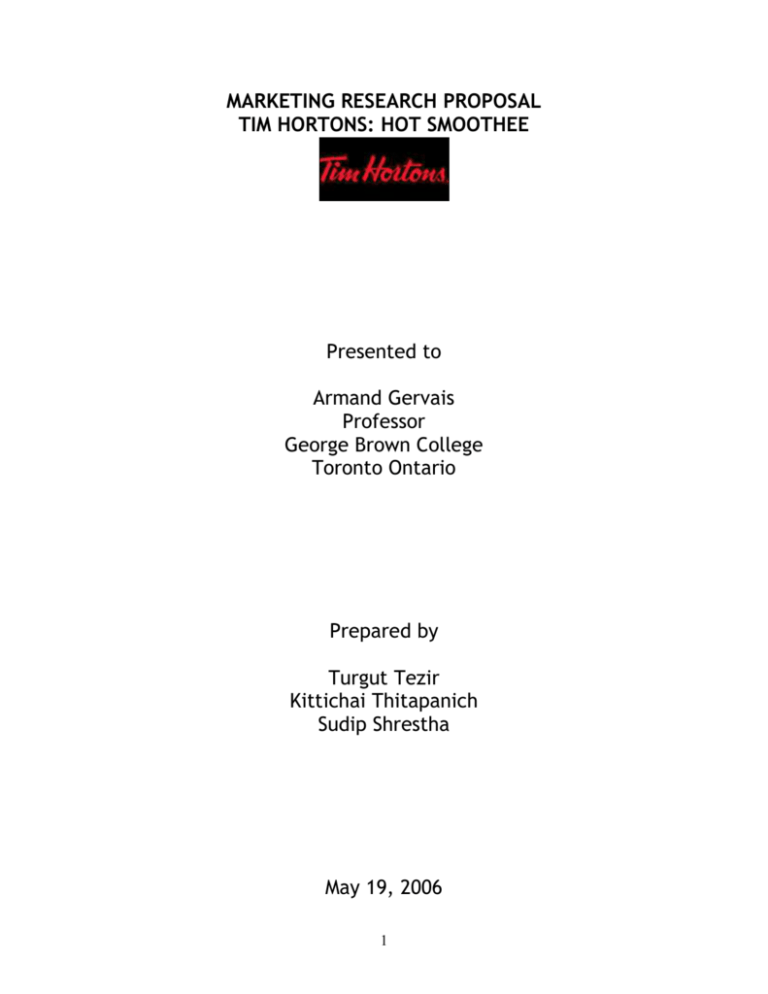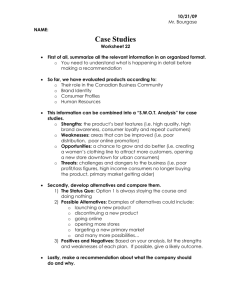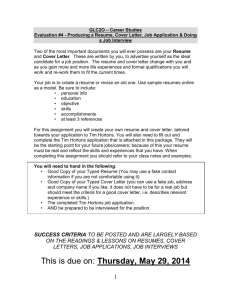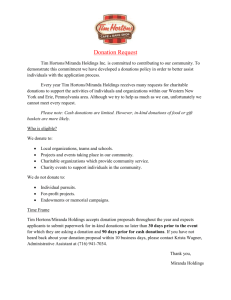1 - Turgut Tezir
advertisement

MARKETING RESEARCH PROPOSAL TIM HORTONS: HOT SMOOTHEE Presented to Armand Gervais Professor George Brown College Toronto Ontario Prepared by Turgut Tezir Kittichai Thitapanich Sudip Shrestha May 19, 2006 1 May 19, 2006 Mr. Armand Gervais 874 Sinclair Rd. Oakville, ON, L6K 2Y1 Dear Mr. Gervais, In order to determine the root cause of dwindling sales of the Hot Smoothee, we have taken the initiative to conduct a thorough market research. This market research will help Tim Hortons identify any problems related to the marketing of the product or if the real reason behind the declining demand is in the composition of the product itself. The conclusions however will be drawn not solely on intuition or gut-feeling but on analysis of data obtained from conducting extensive surveys with Tim Hortons customers. A focus group is also planned to get feedback from Tim Hortons customers. Furthermore, our team will survey Tim Hortons competitors in the same product category and based on the analysis of the data obtained, our team will draw conclusions and formulate recommendations and implementation plans. We have identified our target audience, our objectives and methods for gathering data in detail in the proposal. With accurate pinpointing of the cause of the declining sales of the Hot Smoothee, we are confident we will be able to actually increase sales. Please find the detail information in the enclosed marketing research proposal. We would be glad to answer any queries or concerns you may have. Yours truly, Turgut Tezir Kittichai Thitapanich Sudip Shrestha 2 TABLE OF CONTENTS Cover Letter ………………………................ i 1. Executive Summary ………………………................ 1 2. Introduction ………………………................ 2 Market and Company Background ………………………................ 2 Research Problem/Opportunity ………………………................ 5 Research Objective and Strategy ………………………................ 5 Information Needs ………………………................ 5 ………………………................ 7 Data Collection Method ………………………................ 7 Sampling Plan ………………………................ 7 ………………………................ 8 Projected Budget ………………………................ 8 Research Schedule ………………………................ 9 ………………………................ 10 3. 4. 5. Methods Administration Bibliography 3 1. EXECUTIVE SUMMARY Tim Hortons, the largest coffee-chain of Canada, launched a new product: The Hot Smoothee in October of 2005. It was a good idea for a product to be consumed in the winter season, however when it came to sales and demand of the product, it wasn’t as successful as anticipated. Our main research objective is to provide all relevant information with regards to sale of Hot Smoothee, and obtain specific data about the cause of dissatisfaction among consumers through a survey and by conducting a focus group. We will choose to conduct a focus group that is randomly selected among the Tim Horton’s customers at George Brown College. Furthermore, our main part of analysis will be from the data obtained from the survey we will be conducting at various Tim Hortons in the Greater Toronto Area. Based on the responses from the survey, our team will analyze and determine the root causes of discontent from the consumption of Hot Smoothee or the causes affecting customers to try the product even for the first time. We will be analyzing our competitors, mainly Starbucks and Second Cup for our research. The reason we have chosen the two companies is because of the existence of similar non-coffee products which can be compared to that of Tim Hortons Hot Smoothee. We however realize that these companies have not invested a lot of time and effort into promoting and popularizing the product. Tim Hortons on the other hand has spent a lot of dollars promoting its Hot Smoothee and so far it has not been very successful. Our research findings will indicate possible factors that have caused this ineffective launch and declining sales of the product. 1 2. INTRODUCTION Market and Company Background a). Industry and its trends Tim Hortons was founded in 1964 as a coffee and doughnut shop and opened its first outlet store in Hamilton, Canada. As of today, they have more than 2600 stores in Canada. There is an outlet store for every 8,707 people in Ontario, compared to one outlet for every 18,906 people in the western provinces of Canada. Also, Tim Hortons has more than 250 outlets in the USA. Tim Hortons has generated revenues of US $1.2 billion for its corporate parent, Wendy's International, for the year 2005. (timhortons.com) Tim Hortons is a dominant player in the coffee-doughnut industry in Canada, and the chain has a 75 percent market share in the industry. In Beginning of March 2006, Tim Hortons Inc. started trading publicly on the Toronto and New York Stock Exchanges thereby increasing its overall value. In Canada, Tim Hortons is not only coffee-doughnut shop, but it caters to the emotional aspect of people as well. One of the primary factors for Canadians choosing Tim Hortons is that they consider this coffee-doughnut shop as a national identity, thus making it a highly successful as well as a highly competitive company in Canada. Tim Hortons is committed to offering “always” fresh, fast, convenient, and a wide variety of products. One of the specialities of Tim Hortons is they want to make sure that their menu is being embellished by constantly adding a new taste. Hot Smoothee became one of its new tastes with its launch in October 2005. 2 The following graph depicts a consumer interest in the Mexican shade-grown Coffee by assessing the Canadian, Mexican, and the U.S. Markets (Mexico is one of the largest exporters of shade-grown coffees to Canadian companies including Tim Hortons). We see that clearly coffee quality followed by the consistent supply seem to be very important attributes in the North American and the Mexican markets. Low prices seem to be only somewhat important when buying or selling coffees. Figure 1 Source: Commission for Environmental Cooperation. 1999. Measuring Consumer Interest in Mexican Shade-Grown Coffee: An Assessment of the Canadian Mexican and U.S. Markets. CEC Secretariat. Pg. 10. Rice, P. McLean, J. 1999. Sustainable Coffee at the Crossroads. Consumer’s Choice Council. Pgs. 29 & 34 b). Competitors Hot Smoothee has a lot of competitors in the market, but the focus is on our primary competitors who have the similar products to which we can compare to. Tim Hortons’ main competitors for the Hot Smoothee have been identified to be Starbucks and Second Cup. A point to mention, although, the competitors don’t have an exact product (in taste and price) like the Hot Smoothee, they do have similar products on their menu. Starbucks offers the Cafe Latte in different tastes and Caramel Macchiato while Second Cup serves Coffee Mocha where customers are able to add different flavours, such as hazelnut or vanilla to the Mocha. 3 For the Competitive Analysis portion of the research, we will be analyzing the competitive situation in more detail. c). Target Market Our examination at Tim Hortons’ Hot Smoothee’s target audience has led us to the following primary and secondary target market. TARGET AUDIENCE DESCRIPTION Primary Target - The age between 15-19 Students Don’t count their calories They live with their parents Their parents’ income 40-60 K Urban Their parents have minivan They live in a house They are not coffee-addicted Mall-shopper They go to the vacations with their parents Secondary Target - The age between 23-30 Who don’t want to take caffeine Don’t count their calories They are self-employed Annually income 30-40K Urban They have cars Mall-shopper Live in a apartment 4 Research Problem/Opportunity The latest launch of Tim Hortons is the non-caffeinated hot beverage: Hot Smoothee. It was introduced with four flavours: butter caramel, raspberry, hazelnut, and orange. However, the introduction of the new product hasn’t brought a great deal of attention from customers as expected. The management wants to know why the Hot Smoothee sales are slacking and why the campaigns initiated for the product have been proven unsuccessful. Research Objectives and Strategy The main purpose of the research is to explain why the Hot Smoothee has not been recognized by the customers and what the resolutions to this problem can be. To attain the objective our team needs to: - To provide all the relevant information pertaining to the sale of Hot Smoothee by conducting a survey. - To obtain specific data about the dissatisfaction in consumers and analyze them. - To show cause of the problem through this analysis. Research Strategy The research problem will be pursued by analyzing the target market behaviour and decisionmaking process when a choice is to be made for a drink-related product. Also the media perception and quality after launching the product is to be assessed. A Questionnaire will be designed to test significant factors that will enable us to find out the cause of the problem. Information Needs In order to enhance the understanding of the market place and customer’s needs and expectations, the following information will be asked: 1. Information about the customers (existing and potential) Demographics (age, gender, status, income, etc.) Psychographics (life style, buying behaviour) Preferences in coffee shop 2. Information regarding the Hot Smoothee Product acknowledge Product satisfaction 5 3. Information regarding the competitors Main competitors’ product Customer satisfaction Marketing and campaign 6 3. METHODS Data Collection Method Data Collection will be conducted via the following ways: 1. Approximately 150 – 250 surveys in Tim Hortons in and around the Greater Toronto Area. Each team member will be conducting at least 50 surveys. 2. A focus group will be organized to discuss the issue at hand. 3. George Brown College online databases, web search engines such as Google, and various other websites will be utilized. 4. Periodicals and books will be also be used for data collection if the need arises. Sampling Plan To accomplish the objective, we require 3 groups of people 1. Tim Hortons Customers - We will approach about 3 stores in Greater Toronto Area and 50 customers in each store. - Customers who often come to Tim Hortons who have never tried a Hot Smoothee before. - Customers who come to Tim Hortons are not trying a Hot Smoothee again. Our intention is to consider data from these customers and draw conclusions based on analysis. 2. Competitor’s Customers - We will approach 2 stores downtown area and survey 50 customers for each store. 3. Focus groups - We will approach number of George Brown College students and ask for involvement and participation in a short focus group session. 7 4. ADMINISTRATION Projected Budget To conduct our marketing research, we need to prepare our budget as follows: Description : 1. Salaries and Wages Pre-test 2x60$ / Person Staffs for each interview x 5 time x @ 60/hourx 2 hours Data Input 10x300 2. Overhead Charges Project management 3. Report Preparation Printing and Copying Computing charge 49 Days x1,000 Cost 120 600 3,000 49,000 0.10x100 x 10 copies 4. Other Expenses Contingencies 100 1,000 2500 Total Projected Budget: $ 56,320 8 Research Schedule Task Week 3 Week 5 Week 7 Week 9 Prepare Proposal Prepare Sampling Plan and Questionnaire Test and submit Sampling Plan and Questionnaire Conduct a Focus Group Prepare Report and Analysis Prepare Final Report and Analysis Present 9 Week 11 Week 13 Week 15 5. BIBLIOGRAPHY A brush with the boss and the skinny on Tim's; [Final Edition] Niall Henry. Times Colonist. Victoria, B.C.: Apr 7, 2006. pg. A.20.FR Business: Sticky fingers; Canadian doughnuts, The Economist, London: Apr 1, 2006.Vol.379, Iss. 8471; pg. 64 CONSUMER TRENDS: DINING-OUT CHOICES A MATTER OF EDUCATION Susan Spielberg. Nation's Restaurant News. New York: May 23, 2005.Vol.39, Iss. 21; pg. 102, 2 pgs Say When: Tim Hortons is one of Canada's great growth stories. To be a great stock it will have to keep up the pace, Thompson, Robert. Financial Post Business Toronto:Mar 2006. p. 32-37 Tim Hortons tiptoes into Starbucks territory: Test-marketing lattes, cappucinos:[National Edition], Hollie Shaw. National Post Don Mills, Ont.:Jan 6, 2006. p. FP1 Front Commission for Environmental Cooperation. 1999. Measuring Consumer Interest in Mexican Shade-Grown Coffee: An Assessment of the Canadian Mexican and U.S. Markets. CEC Secretariat. Page 10 . Sustainable Coffee at the Crossroads. Consumer’s Choice Council. Rice, P. McLean, J. 1999. Pps. 29 & 34 A brush with the boss and the skinny on Tim's; [Final Edition] Niall Henry. Times Colonist. Victoria, B.C.: Apr 7, 2006. pg. A.20.FR Tim Horton’s Annual Report http://phx.corporate-ir.net/phoenix.zhtml?c=195616&p=irolnewsArticle&ID=839721&highlight= StarBucks’s Annual Report http://ir.10kwizard.com/?source=518 www.timhortons.com www.secondcup.com www.starbucks.com http://lfpress.com/cgi-in/publish.cgi?p=128747&x=articles&s=shopping www.coffeeassoc.com/ 10




